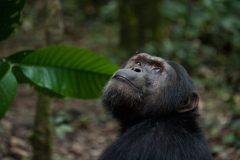- Chimpanzees are adapted to live across diverse habitats in Africa, but little is known about the potential adaptation of chimps in different environments.
- A new study has found that these apes possess genetic traits that help them adapt to different habitat conditions, some of which may be protecting them against malaria.
- The scientists say that, as human activities and climate change continue to threaten chimpanzees’ existence, understanding their genetics and natural history enhances knowledge of how to ensure their long-term survival and conservation.
- Given their vital ecological roles, evolutionary significance, and precarious status, chimpanzee conservation is an urgent global priority.
NAIROBI ― Understanding the genetic traits of chimpanzees and how they help them adapt to unique conditions in different habitats is critical to maintaining their resilience and ensuring long-term survival, according to a study. Some of the genetic traits may even protect the chimps against diseases like malaria.
Habitats of chimpanzee subspecies vary from rainforests to savannahs. To guarantee that individual chimps are adapted to their local environment and to maintain their capacity to continue adaptation, the researchers of the study say, conservation efforts must take into account local genetic adaptation.
“This is particularly relevant, as direct human-induced destruction, climate change, and disease transmission are rapidly changing the environments experienced by chimpanzees,” according to the study.
While chimpanzees are known to inhabit diverse habitats, from forest landscapes to woodland-savannah distributed across East and West Africa, it remains unknown if their genetic adaptation facilitates such habitat diversity.
According to the IUCN red list, all four chimpanzee subspecies are endangered due to habitat destruction, poaching, and infectious diseases, with the western chimpanzee (Pan troglodytes verus) listed as critically endangered, facing the greatest threat of all.

A team of more than 80 researchers from Africa, Europe and North America studied the DNA of 828 wild chimpanzees and found that they had largely adapted to their habitats. The researchers sequenced 828 fecal samples collected across 52 sample sites from 18 countries — Central African Republic, Cameroon, Congo, the Democratic Republic of the Congo, Equatorial Guinea, Gabon, Ghana, Guinea, Guinea-Bissau, Ivory Coast, Liberia, Mali, Nigeria, Rwanda, Senegal, Sierra Leone, Tanzania and Uganda.
Among the great apes, chimpanzees are the closest relatives to human beings, with whom they share over 98% of their distinctive characteristics. And in this study, the researchers discovered genetic changes that help the chimps survive the same way humans have evolved to adapt to malaria.
The study’s lead author Harrison Ostridge, a Ph.D. candidate from University College London (UCL), tells Mongabay that the evidence of adaptation to malaria in chimpanzees linked to the same genes associated with malaria resistance in humans suggests that there may be limited ways through which resistance to the malaria parasite can evolve.
The scientists compared the genetic information from the 388 chimpanzees involved in the final analysis to existing data about their local habitats, identifying the most frequent genetic variants in certain regions against others. They found the strongest evidence of genetic adaptation in GYPA (glycophorin A), a gene responsible for resistance to malaria in humans, and in HBB (hemoglobin), a gene responsible for sickle cell anemia in humans.
“Even if chimpanzees are our closest living relatives,





